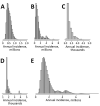Global Estimate of Human Brucellosis Incidence
- PMID: 37610167
- PMCID: PMC10461652
- DOI: 10.3201/eid2909.230052
Global Estimate of Human Brucellosis Incidence
Abstract
Brucellosis is a major public health concern worldwide, especially for persons living in resource-limited settings. Historically, an evidence-based estimate of the global annual incidence of human cases has been elusive. We used international public health data to fill this information gap through application of risk metrics to worldwide and regional at-risk populations. We performed estimations using 3 statistical models (weighted average interpolation, bootstrap resampling, and Bayesian inference) and considered missing information. An evidence-based conservative estimate of the annual global incidence is 2.1 million, significantly higher than was previously assumed. Our models indicate Africa and Asia sustain most of the global risk and cases, although areas within the Americas and Europe remain of concern. This study reveals that disease risk and incidence are higher than previously suggested and lie mainly within resource-limited settings. Clarification of both misdiagnosis and underdiagnosis is required because those factors will amplify case estimates.
Keywords: Brucella; bacteria; brucellosis; brucellosis epidemiology; brucellosis incidence; human brucellosis.
Figures





References
-
- Corbel MJ. Brucellosis in humans and animals. Geneva: World Health Organization; 2006.
-
- World Organisation for Animal Health. WAHIS: World Animal Health Information System [cited 2023 Jul 20]. https://wahis.oie.int
Publication types
MeSH terms
LinkOut - more resources
Full Text Sources
Miscellaneous

